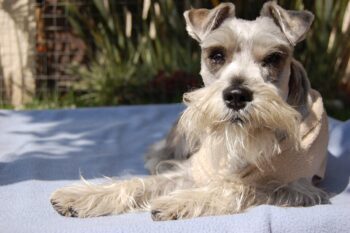Schnauzers, with their distinctive beards and eyebrows, are one of the most recognized and beloved dog breeds in the world. They come in three sizes—Miniature, Standard, and Giant—each with its own personality traits and quirks. However, like many popular breeds, Schnauzers are often misunderstood. Various myths surround these dogs, leading potential owners to form inaccurate opinions about them. Let’s dive into five of the most common myths about Schnauzers that you should stop believing right now.
Myth 1: Schnauzers Don’t Shed at All
One of the most common misconceptions about Schnauzers is that they are completely non-shedding. While it’s true that Schnauzers are considered to be hypoallergenic and shed less than many other breeds, it doesn’t mean they are entirely shed-free.
Schnauzers have a double coat: a wiry outer layer and a softer undercoat. This combination helps them shed minimally, but hair still falls out, especially if their coat is not maintained properly. Regular grooming is essential to keeping their coat healthy and reducing shedding. Many owners opt to have their Schnauzer’s coat clipped or hand-stripped to minimize shedding even further.
Reality: Schnauzers are low-shedding, but they do require regular grooming to maintain their coats. While they are more allergy-friendly than many breeds, they aren’t 100% hypoallergenic.
Myth 2: Schnauzers Are Aggressive Dogs
Another pervasive myth is that Schnauzers, particularly the Standard and Giant varieties, are aggressive dogs. This stereotype likely stems from their history as guard dogs and farm protectors, where they were bred to be watchful and protective.
While Schnauzers can be territorial and have a strong instinct to protect their families, labeling them as inherently aggressive is inaccurate. With proper training and socialization, Schnauzers are known to be affectionate, loyal, and great with children. Like any dog, their behavior depends on how they are raised. If they are socialized early and treated with kindness and respect, they tend to be well-behaved and loving family pets.
Reality: Schnauzers are protective and alert, but they are not naturally aggressive. With proper training and socialization, they can be wonderful companions.
Myth 3: All Schnauzers Are the Same
This myth likely arises from the fact that all Schnauzers share similar physical traits—those signature bushy eyebrows, thick whiskers, and a robust, wiry coat. However, just because they look alike doesn’t mean they all have the same personality. In fact, the three types of Schnauzers—Miniature, Standard, and Giant—differ significantly in terms of temperament and needs.
Miniature Schnauzers are generally lively, playful, and highly trainable. They are excellent for families or individuals living in apartments or smaller homes.
Standard Schnauzers, being the original form of the breed, are often more independent and protective. They need a bit more space and exercise.
Giant Schnauzers are the most robust and intense, often used as working dogs. They require an active owner who can provide them with both physical and mental stimulation.
Reality: Each Schnauzer size comes with its own unique temperament and needs. Miniatures tend to be more playful and adaptable, Standards are independent, and Giants are active and work-oriented.
Myth 4: Schnauzers Are Stubborn and Hard to Train
Some people claim that Schnauzers are difficult to train due to their stubbornness. This myth likely stems from their independent nature, particularly in the Standard and Giant varieties. While Schnauzers can be strong-willed, it’s not fair to say they are untrainable.
Schnauzers are highly intelligent dogs, and with the right approach, they can excel in obedience and training activities. The key is consistency and positive reinforcement. Harsh training methods will only make them more resistant, as they don’t respond well to negative treatment. Schnauzers often thrive when they are given jobs to do or are mentally stimulated with puzzle games and agility exercises.
Reality: Schnauzers are intelligent and can be trained effectively with positive reinforcement. They may be independent, but they are far from untrainable.
Myth 5: Schnauzers Are Aloof and Don’t Enjoy Cuddling
Because of their dignified appearance and alert stance, some people believe that Schnauzers are aloof dogs that don’t enjoy being affectionate. This is far from the truth! In fact, most Schnauzers form very close bonds with their families and thrive on attention and companionship.
Miniature Schnauzers, in particular, are known for being cuddly and affectionate with their owners. While they may be wary of strangers (thanks to their protective instincts), they are often very loving toward their family members. Even Standard and Giant Schnauzers, with their strong working dog background, enjoy being close to their people and are known to be incredibly loyal.
Reality: Schnauzers may have an independent streak, but they love their families and enjoy affection just as much as any other dog.
Conclusion
Schnauzers are an amazing breed, full of personality, intelligence, and love. Like any breed, they have specific traits and characteristics, but they are far from the misconceptions that surround them. Whether you’re considering adopting a Miniature, Standard, or Giant Schnauzer, it’s important to look past the myths and learn about the breed’s real nature. They’re protective but not aggressive, low-shedding but not hypoallergenic, and intelligent yet trainable. With the right care, training, and understanding, a Schnauzer can be an excellent addition to any household.
Before making any assumptions about Schnauzers or any other breed, always make sure to do your research and consult with breed experts or veterinarians to get an accurate picture of what living with a Schnauzer is really like. By dispelling these myths, you can set the foundation for a rewarding and happy relationship with your future furry friend.
The post 5 Myths About Schnauzers You Should Stop Believing appeared first on iHeartDogs.com.

